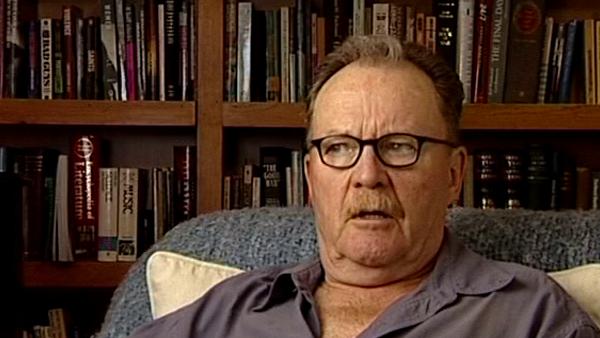NEXT STORY

Memories of filming The Last Detail
RELATED STORIES

NEXT STORY

Memories of filming The Last Detail
RELATED STORIES


|
Views | Duration | |
|---|---|---|---|
| 11. Two kinds of lighting: documentary and theatrical | 423 | 03:36 | |
| 12. Memories of filming The Last Detail | 316 | 02:06 | |
| 13. The White Dawn: Working in the Arctic with the Inuit | 240 | 05:10 | |
| 14. Operating on Jaws | 449 | 04:32 | |
| 15. Jaws and seasickness | 328 | 02:16 | |
| 16. Death Be Not Proud | 207 | 01:00 | |
| 17. Taxi Driver: Small budget but big players | 494 | 02:04 | |
| 18. Taxi Driver: The best movie of my career | 603 | 04:20 | |
| 19. The advantage of being young, naive and egotistical | 404 | 01:55 | |
| 20. Storyboards | 1 | 427 | 01:57 |


On a set the light only exists because you put it there, and so... now, you may simply try and make it look as much as possible like a garage or a dance hall or whatever, but almost always, if it's a set, you try and bring some... some storytelling emotionality to the lighting. Probably you shouldn't, but you do... or maybe you shouldn't, I don't know about that; there is no real answer to that. As... just as there's no real answer to 'is lighting simply enhancing reality or... or making reality', it's... it's some of both, I mean, the... there are two poles in lighting – one is of theatricality and one is of documentary – and every scene in every movie is somewhere in a graph between those two, you know. I mean, in... in... well, for instance in... one of the basic images of art... of painting, of art in general, is the light coming down and striking the person, you know, the light of heaven coming down onto a martyr or... or Christ on a cross, or something like that or.. or a shower of gold coming down to Danae to seduce her, and it's Zeus. That's the basis of theatrical lighting, I think; that's the... the most basic image of theatrical lighting, which is that that light comes down and points out what you're to see and where you're to look in the frame. You know, to look at Danae, surrounded by a shower of gold, or you’re to look at a martyr on the cross with the light of heaven shining down on him, and it tells you where to look.
The other opposite of that is... is still photography – documentary still photography, still photography of the 19th century – when still photography was first invented, and they would come to you and they would... with a picture and they would say, ‘These are what dead bodies on a battlefield look like, these are what the Egyptian pyramids look like’, and they actually look like that, when no one has ever... no painting, no drawing, has ever been able to, up... up until then, tell you, this is what the goddamn pyramid looks like, and this is what a dead body on a field of Gettysburg looks like. That's one end of cinematography, and the other end is the light coming down from heaven. And every scene in every movie is... is a kind of narrative between those two poles, you know – a kind of graph I suppose would be the right word. So it's just a question of how much... how much in one direction do you go, or how much in the other direction do you go, and that's determined by the subject matter and the director and the political situation of the movie and all sorts of things.
A... a good example of... of the documentary end is... is [The] Last Detail, where there was very little light and... and indeed, what we were trying to say is, this is what... here are these sailors and they're wandering around, you know, so the East Coast in the United States in 1972, and this is what it looks like. So you don't need to... you don't want... plus they had these marvelous black suits on and white hats, so the eye... the eye knew exactly where to go. I mean, they looked like wonderful penguins wandering around and so you always knew where to see them anyway. But the other example... what's the other end of an example I can think of in something I did? Oh I don't... we don't, anyway... the... all I'm saying is that that's... there is no one answer to those things. It goes between one and the other, always in movies. And... and my own preference, probably, is for the documentary end, but I hope that I can sort of hold my end up if I have to go to the other end to the theatrical end and I... and from time to time I have.
Michael Chapman (1935-2020), an American cinematographer, had a huge influence on contemporary film-making, working on an impressive array of classic films including 'Taxi Driver', 'Raging Bull', 'The Lost Boys' and 'The Fugitive'.
Title: Two kinds of lighting: documentary and theatrical
Listeners: Glen Ade Brown
British Director of Photography and Camera Operator Glen Ade Brown settled in Los Angeles 10 years ago.
He has been working on features, commercials and reality TV. He played an instrumental role in the award-winning ABC Family series "Switched"
and is also a recipient of the Telly and the Cine Golden Eagle awards for Best Cinematography. He was recently signed by the Judy Marks Agency and is now listed in her commercial roster.
Tags: The Last Detail, 1972
Duration: 3 minutes, 36 seconds
Date story recorded: May 2004
Date story went live: 24 January 2008